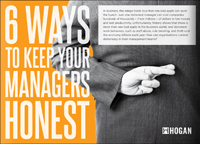 We’ve all dealt with them – the employee that makes questionable decisions around the office, whether that’s stealing some pens from the supply closet or, more seriously, pocketing company revenue on the sly.
We’ve all dealt with them – the employee that makes questionable decisions around the office, whether that’s stealing some pens from the supply closet or, more seriously, pocketing company revenue on the sly.
It’s “time to admit that some people are more vulnerable to unethical temptations than others,” says Dr. Tomas Chamorro-Premuzic, Hogan Assessments’ vp of research and innovation, “and managers can play an important role in attenuating (or increasing) the rate of unethical incidents in their teams and organizations.” Here are some tips on how to manage these morally weak employees.
Engage them. Even less ethical individuals will be more likely to act morally if they are engaged at work. By the same token, alienating employees may enhance moral disengagement even in those with higher integrity.
Lead by example. For managers, the implication is clear: if you want your employees to act morally, start by acting morally yourself.
Pair them with ethical peers. Teaming your less moral employees with colleagues who have strong integrity will motivate them to behave more ethically. Humans learn via observation and imitation, and much of this learning occurs without awareness.
Invest in moral training. Organizations can influence employees’ ethical choices via explicit educational programs. For example, the Ethics Resource Center reports that businesses that implement formal programs to support ethical choices, such as whistleblowing, decrease counterproductive behaviors and misconduct rates, as well as increasing employee satisfaction.
Reduce their temptation. Everybody has a dark side, but the antisocial aspects of our personalities are much more likely to surface in toxic environments or situations of weak moral pressure. It is hard to change someone’s personality, but managers can do a great deal to affect the environment employees inhabit.
Create an altruistic culture. Although organizational culture cannot be created overnight, meta-analytic reviews have demonstrated that a caring culture prevents unethical work behaviors, whereas a culture of self-interest promotes them.
Find out how to put these tips into action in our ebook 6 Ways to Keep Your Manager Honest.



 We’ve all dealt with them – the employee that makes questionable decisions around the office, whether that’s stealing some pens from the supply closet or, more seriously, pocketing company revenue on the sly.
We’ve all dealt with them – the employee that makes questionable decisions around the office, whether that’s stealing some pens from the supply closet or, more seriously, pocketing company revenue on the sly. At Hogan we say that reputation is everything. In the workplace the way others view your behavior is much more meaningful than how you view yourself. But this begs the question, who are these “others” that are viewing me, and does my reputation change if the group of “others” change? The answers lie in the norms.
At Hogan we say that reputation is everything. In the workplace the way others view your behavior is much more meaningful than how you view yourself. But this begs the question, who are these “others” that are viewing me, and does my reputation change if the group of “others” change? The answers lie in the norms. 

 Are you being taken in by innovation myths? Tomas Chamorro-Premuzic debunks three falsehoods about being innovative within an organization in a recent
Are you being taken in by innovation myths? Tomas Chamorro-Premuzic debunks three falsehoods about being innovative within an organization in a recent 